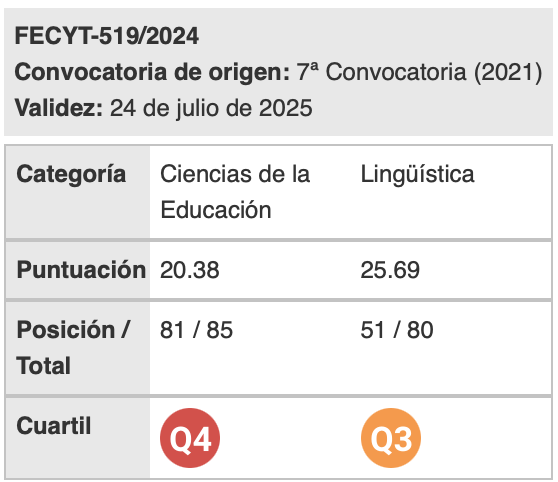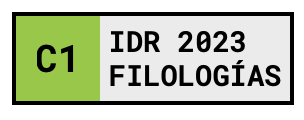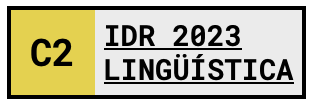Use of complex predicates in 19th century English-language astronomy writings. Exploitation of the Corpus of English Texts on Astronomy
Keywords:
collocation, complex predicate, corpus linguistics, scientific writing, sociolinguistic variablesAbstract
The corpus-based study presented here examines the use of make-complex predicates in nineteenth-century Astronomy. The texts analysed have been taken from the first published section of the Coruña Corpus, the Corpus of English Texts on Astronomy (CETA), compiled by the MuStE group. The concept of complex predicate applied to this study is the one explained by Cattell (1984). As the cor- pus includes extralinguistic information, complex predicates have been analysed applying three different parameters: time-span, origin of the authors and genre or text-type. Taking into account the first parameter, an increase in the use of make-complex predicates from the beginning to the end of the century has been observed; as regards origin, authors from North America made a wider use of these constructions than the ones educated in Europe. Within the European group, texts belonging to Scottish authors arouse the highest number of these collocations followed by England and Ireland. Text-types analysis shows that more specialised text-types tended to use a lower number of complex predicates but essays and articles present similar results as letters, a less specialised genre. Finally, morphological aspects of these complex predicates show that in a great number of examples the noun involved in the complex predicate was used in plural and that a 46.1% of the tokens found had an isomorphic related verb. Further research will focus on the use of complex predicates and the related verbs in the corpus. Data obtained will be compared to the ones found in eigh- teenth-century Astronomy texts to reach conclusions that might be extrapolated to scientific language in general.
Downloads
References
Alonso Ramos, M. (2004). Las colocaciones con verbo de apoyo. Madrid: VisorLibros.
Brinton, L. & Akimoto, M. (1999). Introduction. En L. Brinton & M. Akimoto (Eds.). Collocational and idiomatic aspects of complex predicates in the History of English (1-20). Amsterdam/Philadelphia: John Benjamins.
Bailey, R. W. (1999). Nineteenth-century English. Ann Arbor: The University of Michigan Press.
Biber, D., Conrad, S. & Reppen, R. (1998). Corpus linguistics. Cambridge: Cambridge University Press.
Biber, D., Johansson, S., Leech, G., Conrad, S. & Finegan, E. (2000). Grammar of spoken and written English. London: Longman.
Bonnycastle, J. (1786). An introduction to astronomy in a series of letters from a preceptor to his pupil, in which the most useful and interesting parts of the science are clearly and familiarly explained. London: printed for J. Johnson.
Bosque, I. (2001). Sobre el concepto de colocación y sus límites. Lingüística Española Actual XXIII, 9-40.
Bowen, Cl. (2008). The diachrony of complex predicates. Diachronica 25(2), 161- 184.
Bustos Plaza, A. (2005). Combinaciones verbo nominales y lexicalización. Frankfurt: Peter Lang.
Cattell, R. (1984). Composite predicates in English. Sydney, Australia: Academic. Claridge, C. (2000). Multiword verbs in early Modern English: A corpus-based study.
Amsterdam/Atlanta: Rodopi.
Curme, G. O. (1947). English grammar. New York: Barnes and Noble.
Dirven, R. & Putseys, Y. (Eds). (1989). A user’s grammar of English: Word, sentence, text, interaction. Frankfurt am Main/New York: Lang.
Dixon, R. M. W. (1992). A new approach to English grammar on semantic principles. Oxford: Clarendon.
Gledhill, Ch. (2000). Collocations in scientific writing. Tübingen: Narr.
Halliday, M. A. K. & Martin, J. R. (Eds). (1993). Writing science: Literacy and
discursive power. Pittsburgh: Pittsburgh UP.
Harris, J. (1719). Astronomical dialogues between a gentleman and a lady: wherein the doctrine
of the sphere, uses of the globes, and the elements of astronomy. London: T. Wood.
Hiltunen, R. (1999). Verbal phrases and phrasal verbs in EModE. En L. Brinton & M. Akimoto (Eds.). Collocational and idiomatic aspects of complex predicates in the History of English (133-166). Amsterdam/Philadelphia: John Benjamins.
Jespersen, O. (1954). A Modern English Grammar on historical principles. Part VI Morphology. With the assistance of P. Christophersen, N. Haislund y K. Schibsbye. London: George Allen & Unwin.
Koike, K. (2001). Colocaciones léxicas en el español actual: Estudio formal y léxico- semántico. Alcalá de Henares: Alcalá UP.
Kytö, M. (1999). Collocational and idiomatic aspects of verbs in Early Modern English. En L. Brinton & M. Akimoto (Eds.). Collocational and idiomatic aspects of complex predicates in the history of English (167-206). Amsterdam/Philadelphia: John Benjamins.
Lareo, I. & Esteve Ramos, M. J. (2008). 18th century scientific writing: A study of make complex predicates in the Coruña Corpus. ICAME Journal, 32, 69-96.
Lareo, I. (2009a). Make-collocations in nineteenth-century scientific English. Studia Neophilologica, 81, 1-16.
Lareo, I. (2009b). Estudio de las estructuras verbo-nombre en un corpus de textos literarios. Las colocaciones en Inglés Moderno Tardío. München: Lincom.
Lareo, I. (2010). New trends exploring the language of science: The Corpus of English Texts on Astronomy (CETA) and its tool (CCT) in the context of the Coruña Corpus. En M. Ll. Gea-Valor, I. García-Izquierdo & M. J. Esteve (Eds.) Linguistic and translation studies in scientific communication (131-156). Bern: Peter Lang.
Lareo, I. (en prensa). The Corpus of English Text on Astronomy (CETA). A corpus- driven approach to explore the use of complex predicates in 18th century English scientific writing. En I. Moskowich & B. Crespo (Eds.). Astronomy ‘playne and simple’: The writing of science between 1700 and 1900. Amsterdam/ Philadelphia: John Benjamins.
Live, A. H. (1973). The TAKE-HAVE phrasal in English. Linguistics, 95, 31-50.
Matsumoto, M. (1999). Composite predicates in Middle English. En L. Brinton & M. Akimoto (Eds.). Collocational and idiomatic aspects of complex predicates in the history of English (59-96). Amsterdam/Philadelphia: John Benjamins.
Mel’čuk, I. (1994). Fonctions lexicales dans le traitement du language naturel. En A. Clas & P. Bouillon (Eds.). TA-TAO recherches de point et applications immédiates (193-219). Montréal: Les Presses de l’Université de Montréal.
Moralejo Gárate, T. (2003). Composite predicates in Middle English. München: LIN- COM.
Moskowich, I. (en prensa). “CETA as a tool for the study of modern astronomy in English”. En I. Moskowich & B. Crespo (Eds.). Astronomy ‘playne and sim- ple’: The writing of science between 1700 and 1900. Amsterdam: John Benjamins.
Moskowich-Spiegel Fandiño, I. (en prensa). “A smooth homogeneous globe” in CETA: Compiling late modern astronomy texts in English. En N. Vázquez (Ed.). Creation and use of Historical English Corpora in Spain. Cambridge: Cambridge Scholars Press.
Moskowich-Spiegel Fandiño, I. & Crespo García, B. (2007). Presenting the Coruña Corpus: A collection of samples for the historical study of English scientific writing. En J. Pérez Guerra et al. (Eds). ‘Of varying language and opposing creed’: New insights into Late Modern English (341-357). Bern: Peter Lang.
Moskowich-Spiegel Fandiño, I. & Crespo García, B. (2010). CETA in the context of the Coruña Corpus. Literary and Linguistic Computing, 25(2), 153-164.
Nickel, G. (1968). Complex verbal structures in English. IRAL (International Review of Applied Linguistics), 6 (1), 1-21.
Oxford English Dictionary (OED-online). 2011. Oxford University Press. <http://dictionary.oed.com>.
Poutsma, H. (1914-26). A grammar of Late Modern English. Part I: The sentence. First Half 1928. Part II: The parts of speech. Section IA 1914; IB 1916; II 1926. Groninger: Noordhoff.
Stein, G. (1991). The phrasal verb type ‘to have a look’ in Modern English. International Review of Applied Linguistics in Language Teaching, 29, 1-29.
Watts, I. (1726). The knowledge of the heavens and the earth made easy: or, the first principles of astronomy and geography explain’d by the use of globes and maps: with a Solution of the Common Problems by a plain Scale and Compasses as well as by the Globe. London: printed for J. Clark and R. Hett.
Wierzbicka, A. (1988). The semantics of grammar. Amsterdam/Philadelphia: Benjamins.
Wotjak, G. (1998). Reflexiones acerca de construcciones verbo-nominales fun- cionales. En G. Wotjak (Ed), Estudios de fraseología y fraseografía del español actual (257-279). Madrid: Iberoamericana.
Downloads
Published
How to Cite
Issue
Section
License
Authors who publish with this journal agree to the following terms:
- Authors retain copyright and grant the journal right of first publication with the work simultaneously licensed under a Creative Commons Attribution License that allows others to share the work with an acknowledgement of the work's authorship and initial publication in this journal.
- Authors are able to enter into separate, additional contractual arrangements for the non-exclusive distribution of the journal's published version of the work (e.g., post it to an institutional repository or publish it in a book), with an acknowledgement of its initial publication in this journal.
- Authors are permitted and encouraged to post their work online (e.g., in institutional repositories or on their website) prior to and during the submission process, as it can lead to productive exchanges, as well as earlier and greater citation of published work (See The Effect of Open Access).

Revista de Lenguas para fines específicos is licensed under a Creative Commons Reconocimiento-NoComercial-SinObraDerivada 4.0 Internacional License.
























